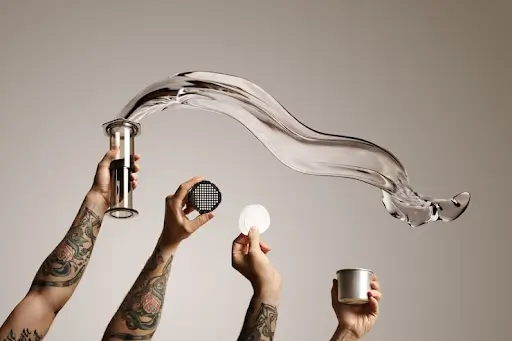How to bring the fizz of a soda to life in a photo, make the viewers taste the sweetness of a chocolate bar, or feel the softness of a cashmere sweater, without touching it? Well, synesthesia is what your new product photography projects needs. Synesthesia, where one sense merges into another, opens up endless possibilities for brands and photographers. Instead of just showing a product, it makes viewers experience it, almost as if they’re inside the photo itself (feeling the product).
With the right understanding of this concept, you can achieve this sensory magic. This blog will guide you through how to use synesthesia as a creative tool to advance your product photography and make every frame unforgettable.
Understanding Synesthesia: Where the Senses Intertwine
What is synesthesia? Let’s make it easy for you to understand.
Synesthesia is a fascinating neurological phenomenon where stimulation of one sense automatically triggers experiences in another. The term comes from the Greek words syn (together) and aisthesis (perception), literally meaning “perceiving together.” For individuals with synesthesia, senses overlap, colors may have tastes, sounds may create visual patterns, or letters and numbers may appear in specific colors. These sensory crossovers occur involuntarily, making them a natural part of how synesthetes experience the world. This unique trait is often present from birth or early childhood and is believed to have a genetic component.
Interestingly, synesthesia isn’t considered a disorder or disease; it’s simply a different way of processing sensory information. While most cases are congenital, certain substances such as LSD, psilocybin, or even caffeine can temporarily induce synesthetic experiences by altering neural pathways.
There are many types of synesthesia, from associating numbers with colors (grapheme-color synesthesia) to tasting words or feeling physical sensations when witnessing touch (mirror-touch synesthesia). Another fascinating form is conceptual synesthesia 90, where abstract ideas, numbers, or even time can evoke colors, shapes, or textures. Each type reveals how uniquely the brain can connect senses, offering a richer, almost artistic perception of reality.
Synesthesia as a Creative Tool
Capturing the Essence of a Product
- Identify the sensory identity – Ask what the product tastes, sounds, or feels like emotionally.
- Think beyond appearance – Capture not just how it looks, but what it does to the senses.
- Example: sparkling beverages – Use splashing droplets, rising bubbles, and bright backlighting to suggest fizz, energy, and refreshment, making viewers almost “hear” and “taste” the product.
- Apply storytelling – Every element in the frame should narrate the sensory experience the product promises.
Color as Emotion: Translating Sound, Smell, and Texture into Visuals
- Understand color psychology – Colors evoke moods, tastes, and emotions subconsciously.
- Bright yellows and greens – Suggest freshness, citrusy zing, and vitality; great for energy drinks or summer products.
- Deep purples and dark blues – Convey luxury, indulgence, or mystery; perfect for premium or evening-themed items.
- Earthy tones – Indicate natural, organic, and grounding qualities; ideal for wellness or eco-friendly products.
- Strategic use of palettes – Incorporate these tones in props, lighting, and backgrounds to enhance the product’s sensory message.
Here, colour synesthesia can be applied strategically, as certain hues subconsciously trigger other senses, allowing viewers to almost taste or hear the emotions tied to the product.
Textures, Motion, and Composition: Making Photos Come Alive
Textures
- Smooth, reflective surfaces visually communicate silkiness or luxury—ideal for skincare or tech.
- Rough, grainy textures imply crunch, ruggedness, or rustic qualities—perfect for artisanal foods or outdoor gear.
- Macro shots can exaggerate texture, making the sense of touch almost real.
Motion
- Flowing fabrics, dripping liquids, or splashing elements inject sound and movement into still images.
- Techniques like freezing motion or using slight blur can simulate the product’s energy or softness.
Composition
- Angular, sharp lines create intensity and boldness.
- Soft, rounded arrangements evoke calmness and elegance.
- Using depth, leading lines, and negative space guides the viewer’s sensory journey.
Practical Applications: Setting the Scene Like a Synesthete
Preparing the Environment Beyond the Frame
- Think immersive, not just visual – Treat your studio as a sensory stage, not just a backdrop. Use soundscapes, scents, and tactile elements during the shoot to inspire your perception while capturing. For example, play effervescent sounds when shooting a soda to influence how you perceive motion and bubbles.
- Control ambiance – Ambient lighting, background props, and even temperature can influence how a product “feels” in the image. Warm surroundings may help you translate coziness into visuals, while a cool, high-key setup works for freshness.
- Use associative props – Not just decorative, props should act as sensory triggers. Cinnamon sticks evoke aroma, dripping honey signals sweetness, and crushed ice suggests chilliness.
Layering Sensory Cues Through Scene Elements
- Integrate sound-inspired movement – Motion in your composition can echo the rhythm of imagined sounds (e.g., a slow fabric flow for calm music vs. splashes that match an energetic beat).
- Smell and taste through visual metaphor – Use vapor, mist, or subtle smoke to suggest aroma; use crystalline textures or glossy finishes to hint at flavor intensity.
- Sensory hierarchy – Decide which sense dominates and let the others support it. For instance, in a coffee shoot, aroma (steam) may take center stage, with textures (beans, foam) adding tactile depth.
Experimenting with Unconventional Techniques
- Synesthetic lighting – Go beyond traditional setups. Try colored gels that mimic the taste or sound associated with the product (e.g., zesty lemon → sharp yellow-green edges, deep wine → velvety red glows).
- Multi-layer compositions – Combine sharp and blurred layers to mimic simultaneous sensory inputs, as the brain would process them in synesthesia.
- Sound-to-visual translation – Some photographers experiment with projecting soundwave patterns, ripples, or vibrations onto surfaces to visually capture “sound” in stills.
Using the Photographer’s Perspective as a Tool
- Shoot while engaging your own senses – Smell the product, taste it if possible, or touch its textures before shooting. This primes your brain to translate those sensations visually.
- Embrace emotional connection – Synesthetic sensory images are not only about senses; they often carry emotional undertones. Ask yourself what mood the product should evoke—playful, luxurious, refreshing, and let that guide every decision.
Application in Different Product Categories
- Food & Beverages – Focus on dynamic elements (splashes, steam, melting textures) to visually trigger taste and aroma.
- Fashion & Textiles – Highlight motion (flowing fabric) and microtextures (weaves, stitching) to make viewers feel the softness or stiffness.
- Fragrances & Cosmetics – Use ethereal lighting, mist, and reflective surfaces to visually suggest scents and skin sensations.
- Tech & Gadgets – Combine sleek compositions, metallic reflections, and futuristic lighting to evoke precision, smoothness, and innovation.

Post-Processing with a Synesthetic Mindset
Post-processing is where synesthetic product photography truly comes to life. Editing should enhance the sensory cues captured during the shoot, ensuring every detail reinforces the intended multi-sensory experience.
- Color Grading with Purpose – Adjust hues to match the product’s sensory identity. For example, boosting warm tones can intensify feelings of comfort, while cooler tints enhance freshness and crispness. Avoid over-saturation; subtlety often conveys sensations more effectively.
- Texture Enhancement – Use clarity, sharpness, and micro-contrast selectively to emphasize textures that suggest touch. Softening certain areas while sharpening others can make fabrics feel silky or foods look crunchy.
- Light and Glow Adjustments – Playing with highlights and shadows can replicate tactile warmth or a sparkling chill. Gentle glows suggest softness, while sharp contrasts evoke intensity.
- Dynamic Effects – Add controlled motion blur, mist overlays, or particle effects to visually imply movement, aroma, or fizz without overwhelming the image.
- Sensory Cohesion – Every edit should align with the product’s sensory story. Over-editing breaks the illusion; the goal is to make the viewer feel, without noticing the manipulation.
Conclusion
The beauty of synesthesia is that it’s accessible to anyone willing to think beyond the visual. Beginners can start with small experiments, playing with lighting, textures, and props, while experienced photographers can push boundaries with complex sensory layering. If you’re ready to take your product visuals beyond the ordinary and create images that truly captivate, Elena Vels Studio is here to bring your vision to life. Specializing in crafting photos that evoke emotion and stimulate the senses, our studio blends artistic creativity with professional expertise to deliver images that resonate with your audience.


